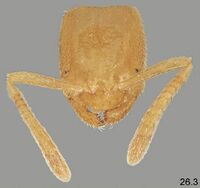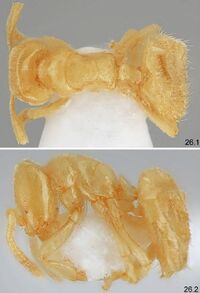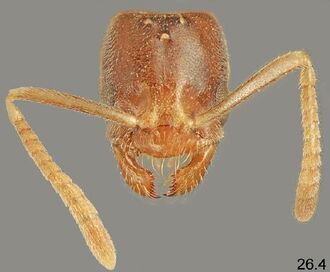Acropyga paleartica
| Acropyga paleartica | |
|---|---|

| |
| Scientific classification | |
| Kingdom: | Animalia |
| Phylum: | Arthropoda |
| Class: | Insecta |
| Order: | Hymenoptera |
| Family: | Formicidae |
| Subfamily: | Formicinae |
| Tribe: | Plagiolepidini |
| Genus: | Acropyga |
| Species: | A. paleartica |
| Binomial name | |
| Acropyga paleartica Menozzi, 1936 | |
LaPolla (2004) - Acropyga palertica has one of the most northerly distributions of any Acropyga species. It has been found in pine forests. This species has been observed in mating swarms in the afternoon, though actual mating was observed by Buschinger et at. (1987) to take place on the tops of rocks, on which both queens and males crawled. Queens were observed to crawl into the soil after dealation. It is a known trophophoretic species associated with E. corinthiacus.
Identification
LaPolla (2004) - Worker: Antennae 11 segmented; 6-8 uneven mandibular teeth; basal tooth offset from masticatory margin. Queen: As in worker with modifications expected for caste. Male: unknown. Compare with Acropyga arnoldi and Acropyga silvestrii.
This species in many ways resembles Acropyga arnoldi, with a high number of mandibular teeth, high number of maxillary palpal segments (up to 5) and a similarly shaped pronotum. The known distributions of the two species are quite different: A. arnoldi is known only from southern Africa. Additionally, A. arnoldi is larger species with head width greater than 0.55 mm, while A. paleartica is known from specimens with head widths less than 0.5 m. Acropyga silvestrii is smaller than A. palearctica with regards to head width, possesses torulae that are much more closely set together.
Keys including this Species
Distribution
Distribution based on Regional Taxon Lists
Palaearctic Region: Greece (type locality).
LaPolla (2004) - This species is the only Acropyga known to occur in the Mediterranean area.
Distribution based on AntMaps
Distribution based on AntWeb specimens
Check data from AntWeb
Countries Occupied
| Number of countries occupied by this species based on AntWiki Regional Taxon Lists. In general, fewer countries occupied indicates a narrower range, while more countries indicates a more widespread species. |

|
Estimated Abundance
| Relative abundance based on number of AntMaps records per species (this species within the purple bar). Fewer records (to the left) indicates a less abundant/encountered species while more records (to the right) indicates more abundant/encountered species. |

|
Biology
LaPolla (2004) - The mealybugs utilized by A. paleartica and Acropyga arnoldi are thought to be closely related to each other (Williams, 1998; see under A. arnoldi for more details).
Buschinger et al. (1987) - The first reported observation from Europe of Acropyga queens carrying mealybug larva in their mandibles during a nuptial flight. Acropyga paleartica queens (incorrectly reported as a Plagiolepis sp.) were seen in a shady pine forest close to Perachora, Greece (near a local monastery; Buschinger, Antwiki 2014) on 7 October 1985. Several mating swarms were found, with the male and female ants flying and crawling upon low, rocky outcrops on the forest floor; actual mating took place on top of the rocks. Each female carried a mealybug larva in her mandibles during flight, after mating, and after dealation, when the females tried to crawl into the soil. A number of specimens were collected and preserved; however, we were unable to find any nests.
Seifert and Heller (1999): An alate queen of Acropyga paleartica was observed carrying a worker pupa during dispersal on her nuptial flight. This was believed to be a redirected activity in connection with the fixed behavioral mechanism of Acropyga to carry a coccoid larva during dispersal, mating, and nest foundation.
Borowiec and Salata (2022), Greece: All specimens collected recently came from soil traps in open habitats with limestones rocks at altitude from 5 to 455 m.
Castes
Queen
Nomenclature
The following information is derived from Barry Bolton's Online Catalogue of the Ants of the World.
- paleartica. Acropyga (Rhizomyrma) paleartica Menozzi, 1936d: 298, fig. XVII (w.) GREECE (Karpathos).
- Type-material: lectotype worker (by designation of LaPolla, 2004a: 77), 3 paralectotype workers.
- [Note: original description cites ca 20w syntypes.]
- Type-locality: lectotype Greece (“Italian Aegean Is”): Scarpanto (= Karpathos I.), Milo stream, 1934 (C. Menozzi); paralectotypes with same data.
- Type-depository: IEUB.
- LaPolla, 2004a: 78 (q.), LaPolla, 2006a: 171 (m.).
- Status as species: Agosti & Collingwood, 1987a: 57; Agosti & Collingwood, 1987b: 279 (in key); Bolton, 1995b: 58; LaPolla, 2004a: 77 (redescription); LaPolla, 2006a: 171; Petrov, 2006: 103 (in key); Legakis, 2011: 26; Borowiec, L. & Salata, 2012: 462; Borowiec, L. 2014: 7; Lebas, et al. 2016: 232; Salata & Borowiec, 2018c: 42; Borowiec, L. & Salata, 2022: 55.
- Distribution: Greece.
Unless otherwise noted the text for the remainder of this section is reported from the publication that includes the original description.
LaPolla (2004) - Unfortunately, I could not locate males for this study despite the fact that they have been collected in the past (Buschinger et al., 1987), and they therefore remain undescribed. Without males I have chosen not to place A. paleartica in a species-group. With a high number of mandibular teeth (up to 8) and a 5-segmented maxillary palp, I suspect that A. paleartica is a primitive species within the genus, perhaps even being closely related A. arnoldi.
Description
Worker
LaPolla (2004) - (n=4): TL: -; HW: 0.462-0.496; HL: 0.549-0.574; SL: 0.441-0.556; ML: 0.47-0.532; GL: - ; CI: 81.18-87.48; SI: 88.91-119.31.
Head: yellow; covered by a layer of short appressed hairs; head distinctly longer than broad; posterior margin entire; 11 segmented, incrassate antennae; apical segment about as long as preceding four segments; scape reaches posterior margin to slightly failing to reach posterior margin; clypeus medially convex, with longer erect hairs on surface; mandible with 6-8 uneven teeth; basal tooth typically offset from masticatory margin; inner mandibular margin nearly parallel with anterior clypeal margin. Mesosoma: yellow; entire mesosoma covered in layer of short appressed hairs; in lateral view, pronotum rounded broadly toward mesonotum; mesonotum flat, at about same level as propodeum; metanotal area often distinct; propodeum dorsum flat; declivity steep. Gaster: yellow; covered in a layer of short appressed hairs, with scattered, longer erect hairs throughout.
Borowiec and Salata (2022) - Very small: HL: 0.556-0.619 (mean 0.587); HW: 0.468-0.492 (mean 0.481); SL: 0.413-0.460 (mean 0.442); EL: 0.032-0.076 (mean 0.047); ML: 0.52-0.68; MW: 0.35-0.41. Color. Whole body and appendages uniformly yellow. Head. Elongate, 1.2-1.3 times as long as wide, parallelsided, occipital margin concave. Clypeus short and transverse, smooth and shiny, anterior margin straight with a row of setae, posterior margin straight in the middle, on sides emarginate by antennal sockets, surface without appressed hairs but with several long, suberect to erect setae, the longest anterior seta with length 0.048. Head micropunctate, interspaces smooth and shiny, without appressed pubescence but with short and dense decumbent hairs, erected setae absent, ventral side of head with short to moderately long, decumbent to semierect hairs. Scape short, 1.1- 1.2 times longer than width of head, stout, clearly widened from base to apex, its surface microreticulate but shiny, with short and dense subdecumbent pubescence, erected setae absent. Funicular segments short except last segment, first segment 1.8 times as long as wide, second segment very short, 1.8 times as wide as long and shorter than third segment, the rest of funicular segments transverse only last segment very long, 2.5 times as long as wide. Eyes very small, in small workers almost rudimental, round or slightly transverse, 0.055 to 0.123 length of head. Mandibles large, without striation. Mesosoma. Stout, 1.5-1.8 times as long as wide, dorsally and laterally mostly with diffused microreticulation, partly smooth, shiny, without appressed pubescence but with short, dense, decumbent to suberect hairs. In lateral view pronotum and mesonotum softly convex, propodeum anteriorly flat then heavily sloping posteriorly, mesonotal groove very shallow. Mesosomal dorsum lacking erected setae. Waist and gaster. Petiole in form of small, thin scale, on top truncate, anterior slope with several decumbent to suberect moderately long hairs. Gaster longer than mesosoma, tergites with diffused microreticulation, surface shiny, covered with short and moderately dense subdecumbent to decumbent pubescence, sides with several elongate decumbent hairs and posterolateral corners of tergites with 1-3 long erected setae. Legs. Short and stout, covered with short and dense subdecumbent hairs, erected setae absent, inner margin of tibiae lacking row of thorns.
Queen
LaPolla (2004) - (n=1): TL: 2.77; HW: 0.577; HL: 0.591; SL: 0.515; ML: 0.952; GL: 1.23; CI: 97.63; SI: 89.25. As in worker with modifications expected for caste.
Male
LaPolla, J.S. 2006: Description of the male of Acropyga paleartica Menozzi, 1936. Myrmecologische Nachrichten 8: 171-173. http://myrmecologicalnews.org/cms/images/pdf/volume8/mn8_171-173_non-printable.pdf
Type Material
Acropyga paleartica Menozzi, 1936: 298 (w.). 4 syntype workers, GREECE: T. Mili; island of Scarpanto (= Karpathos) (C. Menozzi) (IEGG) [examined]. The designated lectotype is a worker labeled JSL # 126 and is deposited at IEGG.
References
- Borowiec, L. 2014. Catalogue of ants of Europe, the Mediterranean Basin and adjacent regions (Hymenoptera: Formicidae). Genus (Wroclaw) 25(1-2): 1-340.
- Borowiec, L., Salata, S. 2022. A monographic review of ants of Greece (Hymenoptera: Formicidae). Vol. 1. Introduction and review of all subfamilies except the subfamily Myrmicinae. Part 1: text. Natural History Monographs of the Upper Silesian Museum 1: 1-297.
- Borowiec, L., Wieczorek, K., Salata, S. 2021. Review of ants (Hymenoptera: Formicidae) of the Dodecanese Archipelago, Greece. Annals of the Upper Silesian Museum in Bytom Entomology 30: 1-33 (doi:10.5281/ZENODO.5571270).
- Buschinger, A., Heinze, J., Jessen, K. et al. 1987. First European record of a queen ant carrying a mealybug during her mating flight. Naturwissenschaften. 74:139–140. doi:10.1007/BF00366526
- LaPolla, J.S. 2004a. Acropyga of the world. Contributions of the American Entomological Institute. 33(3):1-130. (page 77, fig. 32A, worker described)
- LaPolla, J.S. 2006a. Description of the male of Acropyga paleartica Menozzi, 1936. Myrmecologische Nachrichten 8: 171-173.
- LaPolla, J.S., Schneider, S.A. 2023. Trophobiosis between a new species of Acropyga (Hymenoptera, Formicidae) and new Neochavesia (Hemiptera, Xenococcidae) from Peru, and establishment of the Acropyga smithii species-group. ZooKeys 1154, 1–16 (doi:10.3897/zookeys.1154.97578).
- Menozzi, C. 1936b. Nuovi contributi alla conoscenza della fauna delle Isole italiane dell'Egeo. VI. Hymenoptera - Formicidae. Boll. Lab. Zool. Gen. Agrar. R. Sc. Super. Agric. 29: 262-311 (page 298, 299 fig. 17 worker described) http://hol.osu.edu/literature-viewer.html?id=4304&page=298
- Salata, S., Borowiec, L., Trichas, A. 2020. Review of ants (Hymenoptera: Formicidae) of Crete, with keys to species determination and zoogeographical remarks. Monographs of the Upper Silesian Museum No 12: 5–296 (doi:10.5281/ZENODO.3738001).
- Seifert, B. and Heller, G. 1999. Carrying of a worker pupa by a singly-dispersing foundress of Acropyga paleartica Menozzi, 1936 (Hymenoptera: Formicidae). Myrmecologische Nachrichten 3:63-65. [1]
References based on Global Ant Biodiversity Informatics
- Borowiec L. 2014. Catalogue of ants of Europe, the Mediterranean Basin and adjacent regions (Hymenoptera: Formicidae). Genus (Wroclaw) 25(1-2): 1-340.
- Borowiec L., and S. Salata. 2012. Ants of Greece - Checklist, comments and new faunistic data (Hymenoptera: Formicidae). Genus 23(4): 461-563.
- Salata S., and L. Borowiec. 2018. Taxonomic and faunistic notes on Greek ants (Hymenoptera: Formicidae). Annals of the Upper Silesian Museum in Bytom Entomology 27: 1-51.
- Seifert B., and G. Heller. 1999. Carrying of a worker pupa by a single-dispersing foundress of Acropyga paleartica Menozzi, 1936 (Hymenoptera: Formicidae). Myrmecologische Nachrichten 3: 63-65.


